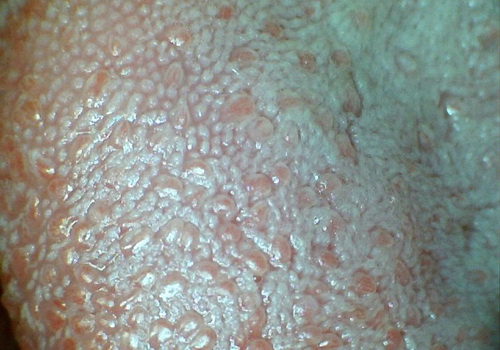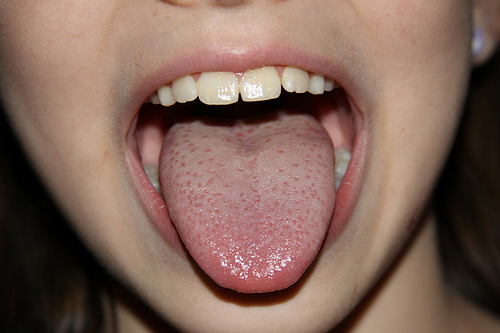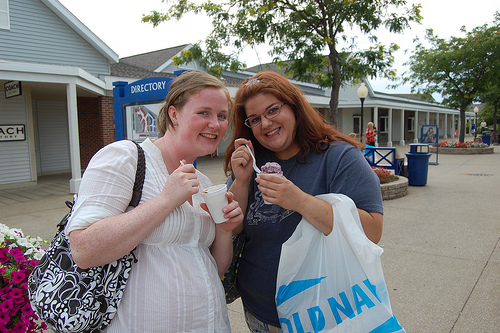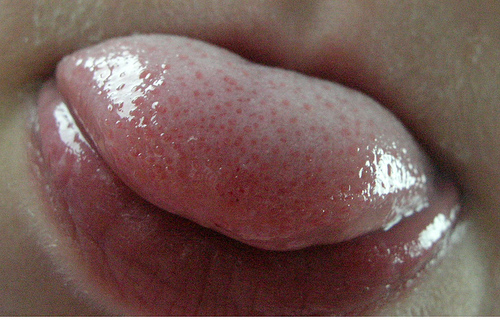
Taste buds, small and unique
Even though they are small, taste buds are considered peripheral organs present on tongue, palate and other areas of the oral cavity. There are around 2000 to 5000 taste buds in your mouth and they possess a very interesting characteristic: they are chemosensory. This means that taste buds respond to chemical stimuli thanks to tiny receptors located on their surface. These receptors, when in contact with chemical components present in food, are activated and then pass a signal through nervous terminals up to the brain. Our brain processes this information, giving us the delicious, and sometimes not so much, ability to sense flavors.
- Important notification about information and brand names used in this slideshow!
- Photo courtesy of Saurabh R. Patil by Wikimedia Commons : commons.wikimedia.org/wiki/File:Tongue_and_taste_buds.jpg
- en.wikipedia.org/wiki/Taste_bud
- http://kidshealth.org/kid/talk/qa/taste_buds.html
- http://www.womansday.com/health-fitness/7-things-you-didnt-know-about-your-taste-buds-119709
- http://www.care2.com/causes/7-things-you-didnt-know-about-your-taste-buds.html
- http://news.softpedia.com/news/8-Amazing-Facts-About-Taste-70253.shtml
- http://www.examiner.com/article/dental-health-101-tongue-taste-buds-slideshow

Bitter, sweet, sour, salty and… umami
Contrary to popular belief, our tongue is not divided into areas. Taste buds are actually spread all over it and can sense each of the five different tastes that exist. Taste buds present on the tongue are able to differentiate between five tastes: sweet, sour, salty, bitter and umami (or savory). Every taste bud is conformed by a group of cells that are specialized on either one of the five different tastes. Cells identified as type II cells can detect sweet, bitter and umami; while type III cells, detect sour taste. It is still not well known which types of cells identify the salty taste.
- Important notification about information and brand names used in this slideshow!
- Photo courtesy of oddharmonic by Flickr : www.flickr.com/photos/oddharmonic/4126087195/
- KINNAMON, S. C. 2013. Neurosensory transmission without a synapse: new perspectives on taste signaling. BMC Biol, 11, 42.

Can you see your taste buds?
Grab a mirror, open your mouth and say ahhh!!! Can you see those red round projections on your tongue? Well, those are not taste buds, but mushroom-like structures called “fungiform” papillae. Taste buds are really small and it is impossible to detect them with the bare eye. They are associated into groups of 6 and located on the surface of papillae. If you take a closer look, you’ll notice that there are more papillae in the front of your tongue, and their number decreases as you go further back. In total, there are around 200 “fungiform” papillae distributed on the surface of the tongue.

Count your taste buds
An average of 5000 taste buds are present on the oral cavity, however, the exact number of these structures varies between individuals and also depends on age. Just as your skin, taste buds are regenerating constantly; however, as time goes by, the ability of regeneration decreases and we loose taste buds with age. Also, sensibility of the remaining taste buds is affected, as we get old. Scientists thought that the number of taste buds also depended on sex; but, in a study conducted in children, differences in taste that where identified depended in the sensitivity of the taste buds, rather than in their number.
- Important notification about information and brand names used in this slideshow!
- Photo courtesy of sean dreilinger by Flickr : www.flickr.com/photos/seandreilinger/2154178092/
- www.nlm.nih.gov/medlineplus/ency/article/004013.htm
- http://www.sciencedaily.com/releases/2008/12/081216104035.htm
- http://www.cf.ac.uk/biosi/staffinfo/jacob/teaching/sensory/taste.html

Taste or flavor?
Taste and flavor are two different concepts. The first one refers to the sensation that the brain produces when certain substances are in contact with the receptors present on our taste buds. Flavor, on the other hand, is the sensation produced by the combination of what taste and smell identify. Remember that there are just five tastes that can be detected by taste buds, but when our sense of taste is combined with the sensations that are gathered by our smell, we can sense the sweet, milky flavor of chocolate, or the dry, fruity flavor of red wine.
- Important notification about information and brand names used in this slideshow!
- Photo courtesy of Evan Bench by Flickr : www.flickr.com/photos/austinevan/3237598408/
- www.nlm.nih.gov/medlineplus/ency/article/004013.htm
- http://www.sciencedaily.com/releases/2008/12/081216104035.htm

From bitter to sweet: Pregnancy and taste changes
Have you heard about dysgeusia? It is the medical term to refer to changes in the sense of taste and is very common to see in pregnant women. As you can imagine, pregnant women experience dramatic hormonal changes, causing not only changes in their bodies and mood, but also in their senses of smell and taste. By evaluating the sense of smell in pregnant women, scientists showed that the sense of taste is affected mainly during the first trimester of the pregnancy, which could be related to the fluctuating levels of estrogen. However, it is still not understood how hormones could alter taste at the brain level.
- Important notification about information and brand names used in this slideshow!
- Photo courtesy of This Year's Love by Flickr : www.flickr.com/photos/hand-nor-glove/3754215874/
- www.pregnancy.org/article/altered-taste-during-pregnancy
- http://science.howstuffworks.com/life/human-biology/pregnancy-affect-senses-of-smell-and-taste.htm
- KUGA, M., IKEDA, M., SUZUKI, K. & TAKEUCHI, S. 2002. Changes in gustatory sense during pregnancy. Acta Otolaryngol Suppl, 146-53.

Taste buds regeneration
Some cells in our body have the capacity to regenerate constantly. Taste buds receptor cells are one of them. Imagine that they can completely regenerate in one day; so, you basically wake up everyday with new taste buds cells. In order for them to continue with this regeneration process, they need certain growth factors and hormones, which are present in saliva. Also, this process wouldn’t be efficient if the old cells didn’t die and stayed there, just getting old and stealing space for the newly generated ones. At the same time cells are generated, old cells die by a controlled process called apoptosis. This process is completely normal and doesn’t cause any harm; however, when taste buds cells are damaged, with very hot milk, for example, the regeneration process is activated in order to replace the death cells.

Your nose and flavours
Try the next experiment: get a piece of your favorite fruit, pinch your nose and give it a bite, to taste it. Now, stop pinching your nose, and bite it again. Did you notice a change in the flavor? This happens because the sense of taste and smell are closely linked. At the same time that our taste buds identify the taste of food through their receptors, cells located on the roof of our nose detect odorants, also present in food. Then, these sensory cells send signals to the olfactory bulb and are finally gathered and combined with signals sent by taste buds receptors, in a specific region of the brain. This is the reason why when you have a constipated nose, food seems to be tasteless. It turns out that your odor receptors are blocked by mucus and can’t detect smell.

A strange superpower: Supertasters
If you could choose a superpower, I’m sure you will go for heightened vision or hearing. Can you imagine being able to identify every single component of your favorite meal? Well, this superpower actually exists, and people able to do this are known as supertasters. This condition has a genetic cause and is related to an increase in the number of papillae on the surface of the tongue. Even though being a supertaster may sound fascinating, people carrying the supertaster gene disagree, because this means that bitter food tastes even bitterer, and sweet food tastes too sweet. Besides, there might be a link between supertaster ability and cancer as a result of avoiding certain foods that their palates just can’t stand.
- Important notification about information and brand names used in this slideshow!
- Photo courtesy of Keith Williamson by Flickr : www.flickr.com/photos/elwillo/6826736654/
- science.howstuffworks.com/life/human-biology/taste4.htm
- http://www.psychologytoday.com/blog/comfort-cravings/201006/are-you-supertaster-mindless-eating-your-taste-buds

Taste and the other senses
Taste not only interacts with smell, but also with the rest of your senses. Have you ever tried something that looks weird or disgusting? I bet you haven’t, because your brain relates its appearance with a bad taste. With sound is a bit different, because it doesn’t affect directly the taste of food, but it can improve, or not, your culinary experiences. If you are in a very crowded restaurant, you will certainly not enjoy your dinner; on the other hand, the sound of food on the grill can make you feel hungrier and increase your sensations while eating whatever you were grilling. Taste and touch interact in a similar way. Food textures can increase the tastiness of certain foods, for example when they feel crispy, rather than when they feel all soggy and humid.



























Your thoughts on this
Loading...